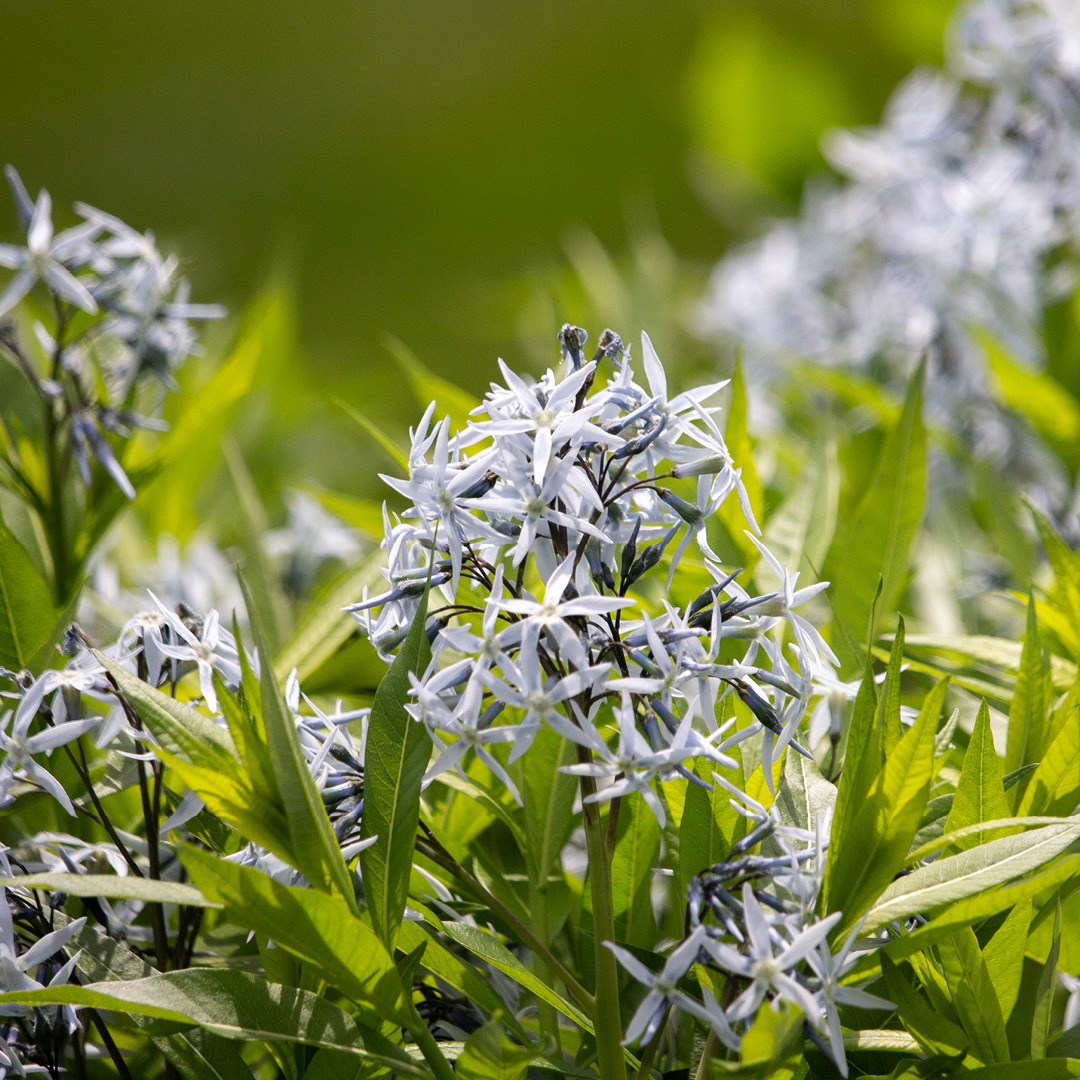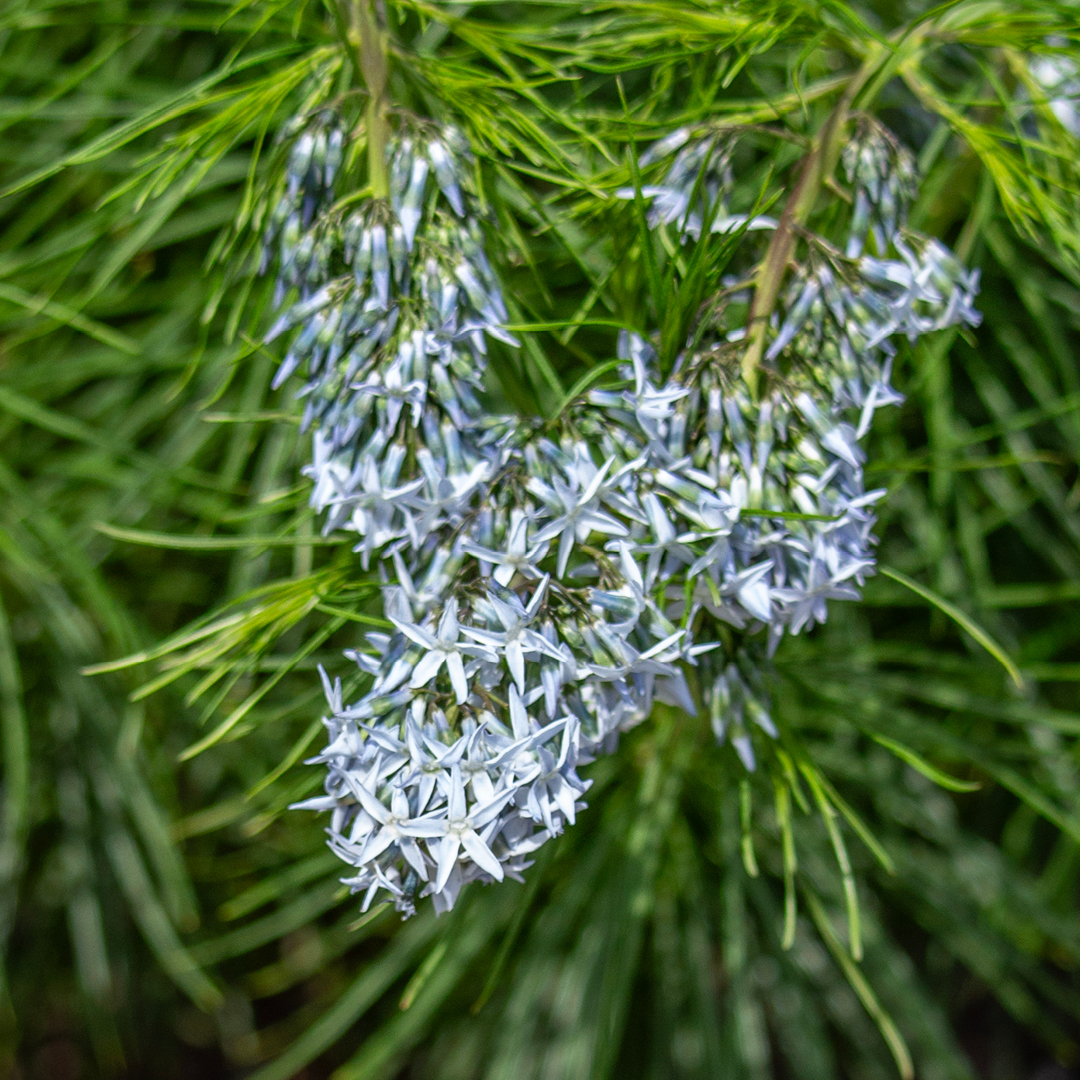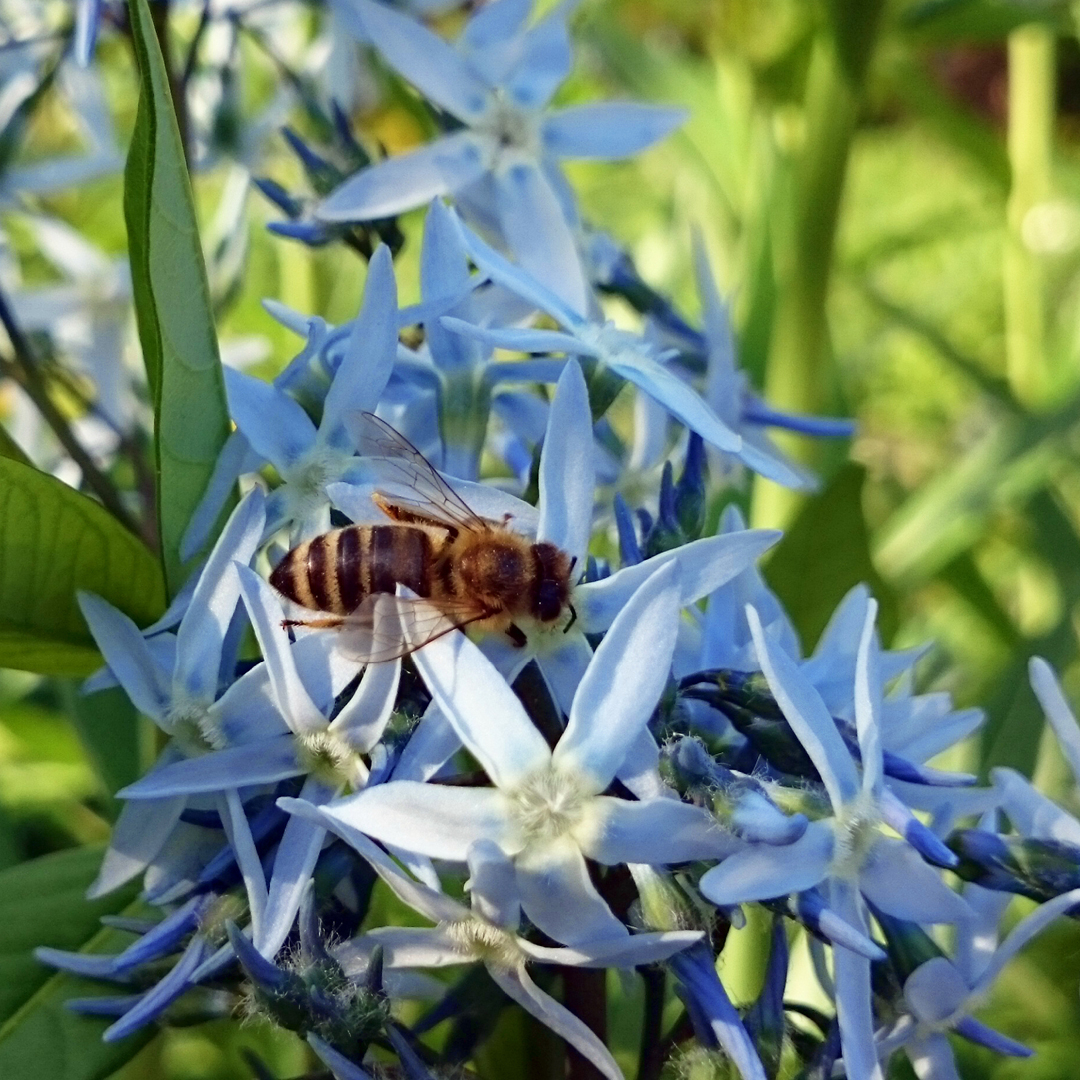America’s ever-increasing love affair with natives has us constantly looking for the finest indigenous plants to grace the modern home landscape. One of the most breathtaking native perennials is Amsonia, commonly called Blue Star.
Amsonia is a genus comprised of approximately 20 species of herbaceous perennials. These plants are characterized by their true-blue, star-shaped flowers and slender foliage. While their late spring blooms may be fleeting, their impact in the garden is enduring for a number of reasons.
Native Plant Benefits
As with all native plants, Blue Star:
- Supports Native Pollinators
Amsonia flowers attract a variety of pollinators, including bees, butterflies, and hummingbirds. - Provides Wildlife Habitat
Blue Star plants’ dense foliage and intricate structure offer shelter for nesting birds, insects, and small mammals, thus enhancing biodiversity and contributing to a more vibrant ecosystem within the landscape garden. - Contributes to Soil Health
Amsonia’s deep root system helps to improve soil structure and fertility, reducing erosion and promoting water infiltration. Additionally, as a perennial plant, it contributes organic matter to the soil as it decomposes at the end of the growing season, further enriching soil health over time. - Reduces Garden Maintenance
Native plants like Amsonia are typically well-adapted to local climate and soil conditions. They typically require less water, fertilizer, and pesticide inputs than non-native species, resulting in a more sustainable and environmentally friendly garden.
Blue Star Benefits
Aside from the usual highlights of simply being a native perennial, Amsonia has many other extraordinary characteristics to offer the landscape garden:
- Long Bloom Time
Amsonia species typically have a long blooming period, with flowers persisting for several weeks in late spring to early summer. - True Blue Flowers
Amsonia are prized for their true-blue flowers, a rarity in the plant world. - Fantastic Foliage
The foliage of Blue Star species, particularly Amsonia hubrichtii, is valued for its fine texture and airy appearance. Its thread-like leaves add a delicate and ethereal quality to the garden, creating a soft and romantic ambiance. - Fall Color
Many cultivars of Amsonia exhibit striking fall foliage coloration. Their leaves transition to vibrant shades of gold, orange, and burgundy, providing a stunning display of autumn color. - Deer Resistance
Amsonia is known for its resistance to deer browsing, making it a valuable addition to gardens and landscapes where deer pressure is a concern. - Versatile Use
Blue Star is suitable for a variety of garden settings, including borders, mass plantings, rock gardens, and woodland gardens. Its graceful habit and fine-textured foliage complement a wide range of companion plants, providing versatility in garden design.
Species Spotlight
There are two noteworthy Amsonia species, A. tabernaemontana and A. hubrictii, each with multiple remarkable cultivars.
Amsonia tabernaemontana
USDA Hardiness Zones: 3-9
Among the notable members of the genus Amsonia is A. tabernaemontana, or Eastern Blue Star. This species, native to the eastern United States, is adaptable to a wide range of climates, from colder regions in Zone 3 to milder climates in Zone 9. It thrives in a variety of habitats, from woodlands to prairies. Its clusters of pale blue flowers, borne atop sturdy stems, herald the arrival of spring, attracting pollinators and delighting gardeners with their breathtaking beauty. With its tolerance for diverse growing conditions and ease of cultivation, Eastern Blue Star remains a beloved choice for gardens seeking a touch of native charm.
Here are some popular cultivars of Amsonia tabernaemontana:
- ‘Blue Ice’
This cultivar is prized for its compact habit and profusion of deep blue flowers. It typically grows to a height of around 12-18 inches, making it well-suited for smaller gardens or container plantings. Its dense foliage and abundant blooms stand out in mixed perennial borders or rock gardens. - ‘Storm Cloud’
‘Storm Cloud’ is celebrated for its striking foliage, which emerges with a rich purple hue in spring before maturing to a deep green. In addition to its foliage, this cultivar produces clusters of light blue flowers in late spring, providing a pleasing contrast against the dark leaves. With a mature height of 24-30 inches, it adds drama to garden compositions and pairs well with other native spring-flowering plants. - ‘Short Stack’
As its name suggests, ‘Short Stack’ is a compact selection reaching a height of just 10-12 inches. Despite its diminutive size, this cultivar boasts the same airy clusters of sky-blue flowers characteristic of the species. It is well-suited for small gardens, edging along pathways, or as a ground cover in sunny to partially shaded areas. - ‘Butterscotch’
This unique cultivar is prized for its foliage, which takes on warm golden-yellow hues in the autumn, reminiscent of butterscotch candy. In addition to its autumnal coloration, it produces clusters of pale blue flowers in spring, creating a delightful contrast against the golden foliage. With its vibrant fall display and early spring blooms, ‘Butterscotch’ adds seasonal interest to gardens and landscapes throughout the year. - ‘Solid Gold’
‘Solid Gold’ is esteemed for its foliage, which emerges in spring with a brilliant chartreuse hue before mellowing to a golden yellow in summer. Unlike other cultivars, it may produce fewer flowers, but its vibrant foliage more than compensates for abridged blooms. This cultivar brightens up shady corners and woodland gardens, providing a pop of color amidst the greenery.
Amsonia hubrichtii
USDA Hardiness Zones: 4-9
Another gem in the realm of native Amsonia is A. hubrichtii, also known as Threadleaf Blue Star. Endemic to the Ouachita Mountains of Arkansas, this species stands out for its feathery foliage, which transitions from vibrant green to golden hues in the autumn months.
Here are some popular cultivars of Amsonia hubrichtii:
- ‘Golden Jubilee’
This cultivar is prized for its vibrant golden-yellow foliage, which emerges in spring and retains its color throughout the growing season. ‘Golden Jubilee’ maintains the graceful habit and fine texture characteristic of the species, making it an eye-catching addition to the garden. - ‘Summer Solstice’
‘Summer Solstice’ is distinguished by its compact growth habit and dense foliage, which forms a tidy mound in the garden. This cultivar exhibits the same thread-like leaves and feathery texture as the species but in a more compact form, reaching a height of 18-24 inches. Its tidy growth habit and foliage make it an excellent choice for smaller gardens or mixed perennial borders. - ‘Cielo Blue’
‘Cielo Blue’ is celebrated for its profusion of sky-blue flowers, which appear in late spring and create a stunning contrast against the fine-textured foliage. In addition to its abundant blooms, this cultivar adds movement and visual interest to garden compositions. - ‘Starfish’
‘Starfish’ is prized for its unique foliage, which exhibits a slightly broader and more substantial texture compared to the species. This cultivar’s leaves resemble the arms of a starfish, with slightly wider lobes and a more robust appearance. Its distinct foliage adds architectural interest and texture to garden designs, creating a focal point or accent amidst other perennials. - ‘October Skies’
‘October Skies’ is esteemed for its exceptional autumn coloration, with foliage transitioning to brilliant shades of gold, orange, and burgundy in the fall. It adds a burst of color and interest to the landscape as summer transitions to fall.
Incorporating Blue Star into landscape designs offers endless possibilities for creativity and expression. This plant adds a touch of natural beauty to any setting, whether used as a focal point in a perennial border or massed together for a striking display.
Cultivation Tips
For those eager to welcome Blue Stars into their gardens, success lies in understanding their preferences and requirements, which are few. These hardy perennials thrive in well-drained soil and partial to full sunlight. Regular watering during periods of drought and occasional fertilization will ensure robust growth and abundant blooms. Propagation is easily achieved through seed sowing or division, allowing gardeners to propagate their favorite varieties and share the joy of Amsonia with others.
Overall, planting Amsonia in the landscape garden offers a multitude of ornamental and ecological benefits, from supporting pollinators and wildlife to improving soil health and conserving native plant species. By embracing native plants like this breathtaking beauty, gardeners can create landscapes that are stunning, resilient, environmentally sustainable, and ecologically valuable.



